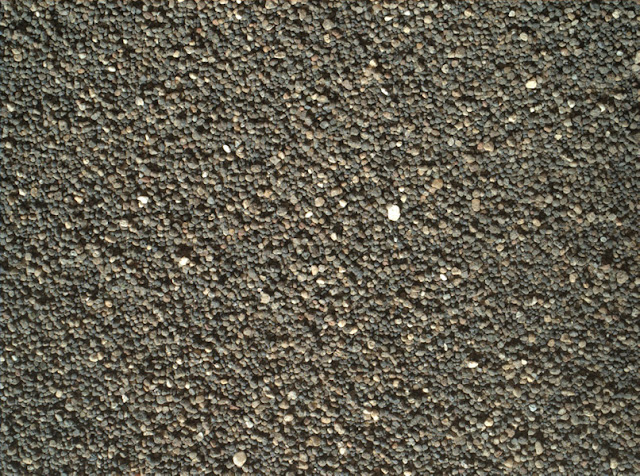NASA - Mars Science Laboratory (MSL) patch.
December 11, 2015
Fast Facts:
- Curiosity is using its wheels, as well as its science payload, to investigate sand that forms active dunes on Mars.
- Plans call for the rover to scoop up and sieve sand for onboard laboratory analysis.
NASA's Curiosity Mars rover has begun an up-close investigation of dark sand dunes up to two stories tall. The dunes are on the rover's trek up the lower portion of a layered Martian mountain.
A view of the rippled surface of what's been informally named "High Dune"
Image above: The rippled surface of the first Martian sand dune ever studied up close fills this Nov. 27, 2015, view of "High Dune" from the Mast Camera on NASA's Curiosity rover. Image Credit: NASA/JPL-Caltech/MSSS.
A wheel track exposing material beneath the surface of a sand sheet nearby
Image above: A wheel track left by NASA's Curiosity Mars rover exposes underlying material in a shallow sand sheet in this Dec. 2, 2015, view from Curiosity's Mast Camera (Mastcam). Image Credit: NASA/JPL-Caltech/MSSS.
The dunes close to Curiosity's current location are part of "Bagnold Dunes," a band along the northwestern flank of Mount Sharp inside Gale Crater. Observations of this dune field from orbit show that edges of individual dunes move as much as 3 feet (1 meter) per Earth year.
Image above: This view shows grains of sand where NASA's Curiosity Mars rover was driven into a shallow sand sheet near a large dune. Image Credit: NASA/JPL-Caltech/MSSS.
The rover's planned investigations include scooping a sample of the dune material for analysis with laboratory instruments inside Curiosity.
Image above: This Dec. 5, 2015, view of the undisturbed surface of a Martian sand dune called "High Dune" shows coarse grains remaining on the surface after wind removal of smaller particles. Image Credit: NASA/JPL-Caltech/MSSS.
Curiosity has been working on Mars since early August 2012. It reached the base of Mount Sharp in 2014 after fruitfully investigating outcrops closer to its landing site and then trekking to the mountain. The main mission objective now is to examine successively higher layers of Mount Sharp.
For more information about Curiosity, visit: http://mars.jpl.nasa.gov/msl
Images (mentioned), Text, Credits: NASA/Dwayne Brown/Laurie Cantillo/JPL/Guy Webster.
Greetings, Orbiter.ch





